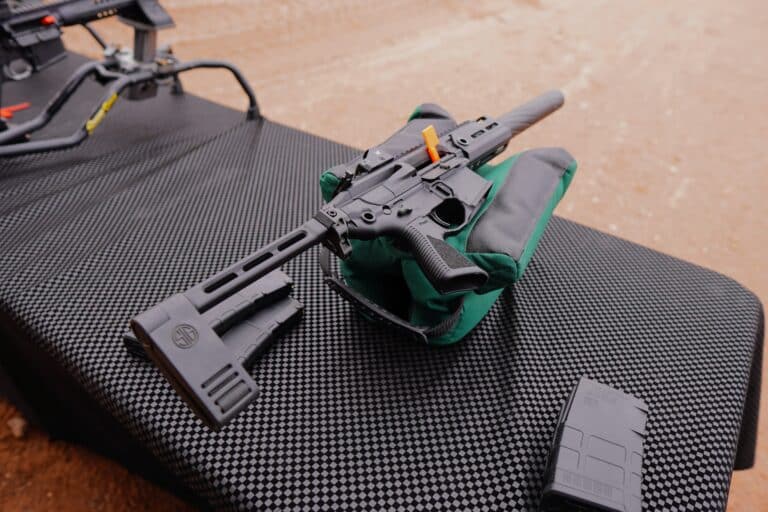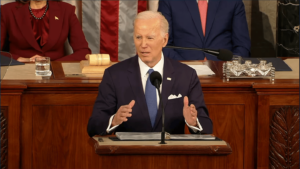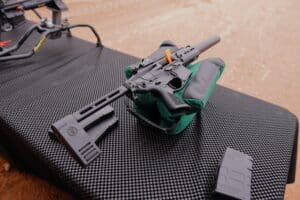“[T]he Second Amendment’ presumptively guarantees’ Plaintiffs Mock and Lewis the right to keep and bear braced (and unbraced) pistol arms at home and in public for general self-defense use.”
That’s the conclusion United States District Judge Reed O’Connor came to in a case on Monday. He found the ATF’s attempt to redefine pistols equipped with stabilizing braces as short-barrel rifles, effectively requiring them to be registered with the agency or otherwise disposed of, is likely unconstitutional because those guns are commonly used for self-defense. Because of that, he issued a preliminary injunction blocking enforcement of the rule against plaintiffs, including members of the Firearms Policy Coalition (FPC).
“[T]he Court finds that the Government Defendants’ implementation and enforcement of the Final Rule substantially threatens to inflict irreparable constitutional harm upon the FPC members,” Judge O’Connor wrote in Mock v. Garland. “Absent injunctive relief, the Final Rule will impair and threaten to deprive them of their fundamental right to keep and bear commonly used arms as a means of achieving the inherently lawful ends of self-defense. See U.S. CONST. AMEND. II (providing that the ‘right of the people to keep and bear Arms, shall not be infringed.’).”
The ruling is the first to touch on Second Amendment claims against the brace rule that President Joe Biden unilaterally implemented. Previous injunctions issued against the rule hinged on findings the ATF didn’t have the authority to reclassify the braced pistols without Congressional input. Judge O’Connor’s ruling expands the impediments Biden’s brace rule faces as the legal fight continues.
Judge O’Connor’s reasoning in the case could also be influential in potential challenges of other gun restrictions because it provides further detail on exactly which kinds of firearms are protected by the Second Amendment.
Mock v. Garland challenged the ATF’s attempt to classify nearly all firearms with a barrel under 16 inches long and a brace attached to them instead of a stock as short-barrel rifles (SBRs). In 2012, the agency said it didn’t consider guns that had short barrels and specialized braces in place of stocks to be designed for shouldering and, therefore, SBRs. But, over the next decade, the agency issued conflicting guidance as the braced pistols became increasingly popular.
By the time it issued its final rule effectively reclassifying all braced pistols as SBRs earlier this year, millions of the guns had been legally sold to people across the country.
The switch in how the ATF defined braced pistols had enormous implications for manufacturers and owners. Unlike pistols, SBRs are subject to the National Firearms Act (NFA) of 1934–the same law that regulates machineguns and silencers. Any gun that falls under the NFA is subject to a $200 tax, and the owner must register it with the ATF to prove they paid the tax. Failing to register with the ATF could lead to felony gun charges that carry hundreds of thousands of dollars in fines and up to a decade in prison.
The ATF gave braced-pistol owners several options to comply with the re-classification. They could dismantle, destroy, or turn in their affected firearms. They were also allowed to keep their guns as is and register them without paying the NFA’s tax.
However, as Judge O’Connor noted in its ruling by citing The Reload’s exclusive reporting, the ATF’s own estimates show very few Americans complied. He concluded that meant both the individual plaintiffs and scores of FPC members would be at risk of prosecution if he didn’t issue an injunction protecting them.
“According to the agency’s most frugal estimates, there are at least 3 million firearms and 1.4 million owners of braced pistols that the Final Rule has now swept under the onerous strictures of the NFA,” he wrote. “The higher end of ATF’s estimates indicate that the Final Rule has consolidated 7 million braced pistols within the NFA’s enforcement thrust. The ATF further anticipates that the Government Defendants’ enforcement of the Final Rule will cause the destruction or forfeiture of over 750,000 firearms. And with the reported registration-compliance rate as low as it is (8%), it does not require any attenuated inferences for the Court to posit that this figure will likely be much greater in the absence of its equitable intervention.”
He argued the ATF’s numbers also underline why its rule likely violates the Second Amendment because Americans commonly use the firearms it seeks to restrict.
“The Second Amendment prohibits government from infringing upon an individual’s right to keep and bear arms for self-defense. This protects an individual’s ‘possession and use of weapons that are ‘in common use at the [present] time,'” Judge O’Connor wrote, citing Supreme Court decisions in District of Columbia v. Heller and New York State Rifle and Pistol Association v. Bruen. “Conversely, protection is not extended to possession or use of ‘dangerous and unusual weapons.'”
Judge O’Connor said the fact that law-abiding civilians own millions of the guns shows they are protected.
“The Government Defendants’ assertion to the contrary—that pistols do become dangerous and unusual as soon as stabilizing braces are attached to them—does not survive its own administrative record,” he wrote. “The ATF’s regulatory analysis concludes that there are between 3 and 7 million, with a fifty percentile estimate of 5 million, braced pistols under the ownership of law-abiding individuals for lawful purposes throughout the United States.”
Though Judge O’Connor is a lower court judge, and his finding is not binding on other courts, his argument provides further support for gun-rights advocates who argue most guns and accessories targetted for bans by activists on the other side of the issue are protected because millions have been sold. If other judges adopt the same standard for judging what is “in common use,” it could spell the end for categorical gun bans in places like California, Massachusetts, New York, New Jersey, Maryland, and elsewhere.
The ruling went after another aspect of the ATF’s enforcement often decried by gun-rights activists and industry members alike: vagueness. Judge O’Connor took particular issue with the ATF’s unclear approach to whether a braced-pistol owner could be prosecuted for having a brace and a pistol nearby each other, even if they aren’t attached. He said the ATF’s guidance on that point was “simply too broad and unclear for the FPC members to understand or otherwise decipher.”
“The Court finds that this record presents a ‘credible threat of a potential felony indictment’ against each of the FPC members if they proceed with their intent to maintain current possession of their braced (or unbraced) pistols or acquire additional braced pistols for lawful uses in home and self-defense,” Judge O’Connor, a George W. Bush appointee, said. “Mock and Lewis themselves are also disinclined from continuing to possess any unbraced pistols due to the substantial uncertainty behind what the ATF considers to be constructive possession under the Final Rule. It is much more likely therefore that when faced with this ‘credible threat of criminal prosecution’ on the horizon, the two FPC members will resort to surrendering their braced pistols over to ATF or destroying their braced pistols entirely.”
Still, the injunction didn’t include everything plaintiffs hoped to get. Judge O’Connor refused to extend the injunction to every brace owner, even those who aren’t plaintiffs in the case.
“The Court declines Plaintiffs’ invitation to extend the scope of the injunctive relief ‘nationwide,'” he wrote. “Injunctive relief reflecting that previously afforded by the Fifth Circuit to Plaintiffs is sufficiently limited to ‘not provide relief beyond the parties to the case,’ while also affording sufficient relief to meet each Plaintiff’s present needs.”
The Department of Justice did not respond to a request for comment on the ruling or say whether it planned to appeal it.







Only Members can view comments. Become a member today to join the conversation.